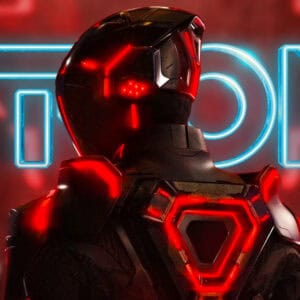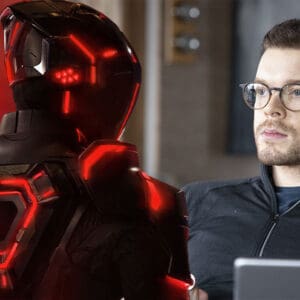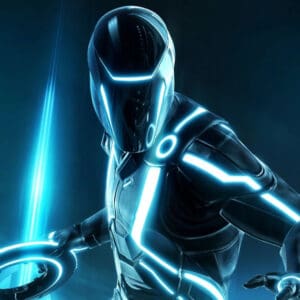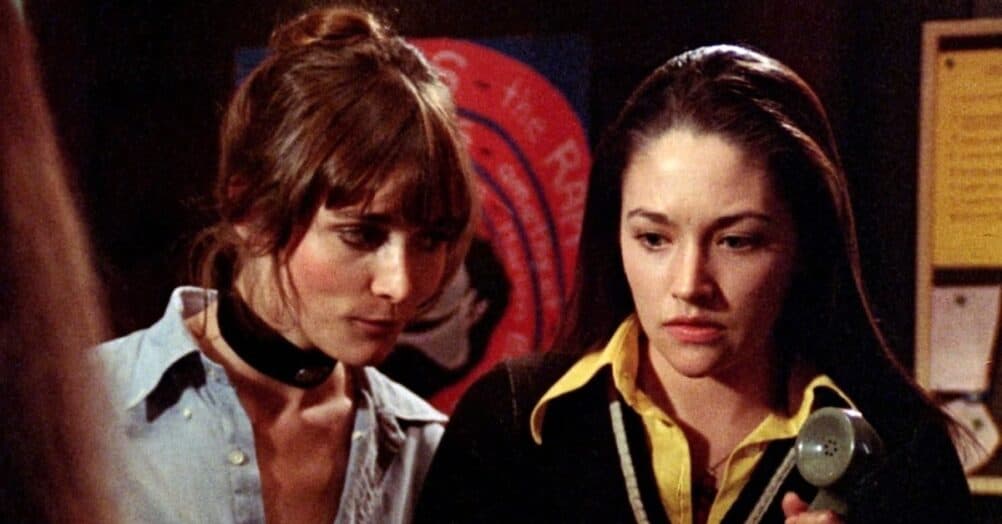
Michael Sheen doesn’t have a whole lot of screentime in TRON: LEGACY (at least not compared to Jeff Bridges, Garrett Hedlund and Olivia Wilde) but he makes the most of his time. He’s arguably having the most fun on screen and his character is a thrill to watch as you try to figure out his motivations: is he here to help or harm our heroes?
We got a chance to talk to Mr. Sheen about joining the film, developing the look for his character and working alongside a young Jeff Bridges. Check it out below!
Michael Sheen
At what point exactly, and what did they say or do, to bring you on to the project?
They didn’t really have to say much, to be honest, because as soon as I heard the word “TRON” I was like, “Yep! I’ll do it.” And I hadn’t even read the script. My agents kept saying, “No, don’t say that. You gotta pretend that they have to win you over. So I went into Disney and Joe did a kind of presentation of everything; took me through the story and showed me the artwork, and the concept – visual concepts – and all that kind of stuff, then showed me a picture of the character and we talked about what he was sort thinking of and I got even more interested. I loved the sound of the character. He wanted him to be a real showman, a completely different kind of energy to the film at that point… so I loved all that so I just kept saying to my agent, “When can I say yes? Say yes!” And so it didn’t take that much really.
It sounds like they brought you on pretty early on in the designing process.
Yeah, it was pretty early. I mean the script wasn’t even finished at that point so I was very, very pleasantly surprised when I did get to read the final script and just thought it was fantastic. Because I knew that the whole look of it was going to be great and I knew that Jeff would be amazing and, you know, all that kind of stuff. But to read the script and actually read it from page one through to the end, in one go, and be totally gripped and really excited with no effect, no technology, none of the stuff that is the big hoopla about the film – just to be absolutely moved and excited and exhilarated by the story itself, that was kind of unexpected but really great.

Which came first, the Ziggy Stardust attitude in your character or the Ziggy Stardust look?
No, the look – originally the look, in terms of making the costume, that was already underway – well, not underway – before I came on, but they kind of knew how they wanted to make the character look in terms of the costume and the costume is not Ziggy Stardust at all. It’s more like a circus showman, like a circus ringmaster, is the actual look of it. But so then it was when I started talking to them and I started thinking about the character and then and I wanted to – I was thinking about if it was a program, what sort of program would this character be: [one] that assimilates, that survives by changing and adapting and that kind of stuff and that’s what made me think of Bowie and then I thought, Well, maybe there’s a way of kind of doing a more futuristic – even though Ziggy originally looks sort of futuristic but – going down that road.
So then I was talking to the make-up and the hair people and we started developing this whole thing and I started watching more stuff and it just seemed to make more and more sense for the character – all the things; I love the ambiguity of Bowie’s Ziggy period. And that was very much apart of the character and that you never quite know where you are with him. Is he someone who’s going to be your greatest friend or he’s going to betray you? Or, what’s he going to do? So I loved all that. And I loved that kind of, almost alien-like gender confusion.
And you’re wearing heels.
And I’m wearing very big heels. I have no eyebrows. And yeah, I sashayed my way around.
Did you get any advice from Olivia Wilde (Quorra) or Beau Garrett (Jem) on how to do that?
Strangely no, I didn’t need any advice. They were looking at me. I was – They were learning tips from me on how to bevel and how to sashay in six-inch heels. I taught them a thing or two.
Hey, if you can own it, right?
Yeah, absolutely.

From what I’ve seen, you guys did a lot of blue screen work, especially with Jeff Bridges’ CLU character that required shooting with both Jeff and a stand-in. Did it ever interfere with you as an actor? Did you have to adopt a different mindset?
I suppose there’s one way of working on a film, as an actor, where if you’re not careful everything interferes with what you’re doing as an actor. In fact, the logical extension of that is you kind of go, “Can you get that camera out of the way, please? Because it’s interfering with what I’m doing as an actor.” So you can either resist everything technical or you can embrace everything technical. And if you embrace it, it’s a lot easier of a job. If you don’t embrace it, you can end up shouting at soundguys because they’re in your eyeline. So you gotta be careful about things like that, I think. And I think when you’re working on green screen stuff and – you know, the more technological advance something is the more it can just do your head in if you’re not careful. Or, the way I sort of see it is it’s more like acting in your bedroom when you’re a kid. Then you don’t have anything, there’s nothing there. It’s just you and your imagination and you pick up a stick and it’s a sword or you pick up a cardboard box, put it on your head and it’s a crown or a helmet.
And it’s sort of like that working with green screen stuff, I think; that you just have to go with your imagination and any of the technical stuff, sort of look for how it can help you. So we’re doing a scene with Jeff where – Jeff playing his younger self – you get to do the scene with Jeff and you rehearse it a few times, you get a sense of what’s going on, and then Jeff goes away and then someone else comes along and then you do it again with this other person and you get – and you have the opportunity to discover new things about the scene because someone else is there. And then when Jeff comes back and you do it with Jeff again or whatever, you know, you build it up and so it becomes more multi-layered, potentially. So I kind of like that aspect. I didn’t have to do too much green screen stuff – blue screen stuff, because the night club set was a permanent set, it was a huge set with hundreds of people and so it was more like doing a conventional film. So I wanted more green screen stuff, I wanted to do more of that stuff.
So obviously as TRON film, you’re in love with the original. Is there anything that makes a reappearance that you’re just so psyched to see again or work with?
Well, Jeff Bridges probably more than anything else; that is what I was most excited about. But each time we see more footage – ’cause I’m an audience member as much as anyone else. I’m watching the footage as everyone else is – and each time you see a new element that was kind of based on something from the first film but is being taken a little bit further or taken in a different direction, it’s just really exciting. So, you know, watching – there’s that sequence where you see, I think it’s CLU, diving through the air and then suddenly he’s in something that flies and it’s kind of based on one of those things from the first film but it’s been taken in a different direction. I just go crazy watching it. It’s great.




















Follow the JOBLO MOVIE NETWORK
Follow us on YOUTUBE
Follow ARROW IN THE HEAD
Follow AITH on YOUTUBE